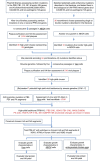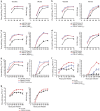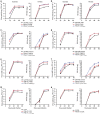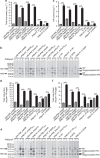Development of high-yield influenza A virus vaccine viruses
- PMID: 26334134
- PMCID: PMC4569720
- DOI: 10.1038/ncomms9148
Development of high-yield influenza A virus vaccine viruses
Abstract
Vaccination is one of the most cost-effective ways to prevent infection. Influenza vaccines propagated in cultured cells are approved for use in humans, but their yields are often suboptimal. Here, we screened A/Puerto Rico/8/34 (PR8) virus mutant libraries to develop vaccine backbones (defined here as the six viral RNA segments not encoding haemagglutinin and neuraminidase) that support high yield in cell culture. We also tested mutations in the coding and regulatory regions of the virus, and chimeric haemagglutinin and neuraminidase genes. A combination of high-yield mutations from these screens led to a PR8 backbone that improved the titres of H1N1, H3N2, H5N1 and H7N9 vaccine viruses in African green monkey kidney and Madin-Darby canine kidney cells. This PR8 backbone also improves titres in embryonated chicken eggs, a common propagation system for influenza viruses. This PR8 vaccine backbone thus represents an advance in seasonal and pandemic influenza vaccine development.
Conflict of interest statement
J.P., C.A.N., E.G., C.A.M., A.F., M.I, E.A.M, and T.J.S.L. have no competing interests. G.N. and Y.K. are Co-founders of FluGen. Y.K. is also a paid consultant of Crucell.
Figures







Similar articles
-
Optimization of influenza A vaccine virus by reverse genetic using chimeric HA and NA genes with an extended PR8 backbone.Vaccine. 2015 Aug 20;33(35):4221-7. doi: 10.1016/j.vaccine.2015.06.112. Epub 2015 Jul 21. Vaccine. 2015. PMID: 26206270
-
The PB1 segment of an influenza A virus H1N1 2009pdm isolate enhances the replication efficiency of specific influenza vaccine strains in cell culture and embryonated eggs.J Gen Virol. 2016 Mar;97(3):620-631. doi: 10.1099/jgv.0.000390. Epub 2016 Jan 7. J Gen Virol. 2016. PMID: 26743314
-
Molecular signature of high yield (growth) influenza a virus reassortants prepared as candidate vaccine seeds.PLoS One. 2013 Jun 11;8(6):e65955. doi: 10.1371/journal.pone.0065955. Print 2013. PLoS One. 2013. PMID: 23776579 Free PMC article.
-
Cell-Based Manufacturing Technology Increases Antigenic Match of Influenza Vaccine and Results in Improved Effectiveness.Vaccines (Basel). 2022 Dec 26;11(1):52. doi: 10.3390/vaccines11010052. Vaccines (Basel). 2022. PMID: 36679895 Free PMC article. Review.
-
Cell-based influenza vaccines: progress to date.Drugs. 2008;68(11):1483-91. doi: 10.2165/00003495-200868110-00002. Drugs. 2008. PMID: 18627206 Review.
Cited by
-
Characterization of Mouse Monoclonal Antibodies Against the HA of A(H7N9) Influenza Virus.Viruses. 2019 Feb 11;11(2):149. doi: 10.3390/v11020149. Viruses. 2019. PMID: 30754701 Free PMC article.
-
Efforts to Improve the Seasonal Influenza Vaccine.Vaccines (Basel). 2018 Mar 30;6(2):19. doi: 10.3390/vaccines6020019. Vaccines (Basel). 2018. PMID: 29601497 Free PMC article. Review.
-
Susceptibility of Influenza Viruses to the Novel Cap-Dependent Endonuclease Inhibitor Baloxavir Marboxil.Front Microbiol. 2018 Dec 6;9:3026. doi: 10.3389/fmicb.2018.03026. eCollection 2018. Front Microbiol. 2018. PMID: 30574137 Free PMC article.
-
The effect of mutations derived from mouse-adapted H3N2 seasonal influenza A virus to pathogenicity and host adaptation.PLoS One. 2020 Jan 9;15(1):e0227516. doi: 10.1371/journal.pone.0227516. eCollection 2020. PLoS One. 2020. PMID: 31917822 Free PMC article.
-
A peptide-based approach to evaluate the adaptability of influenza A virus to humans based on its hemagglutinin proteolytic cleavage site.PLoS One. 2017 Mar 30;12(3):e0174827. doi: 10.1371/journal.pone.0174827. eCollection 2017. PLoS One. 2017. PMID: 28358853 Free PMC article.
References
-
- Wright P. F., Neumann G. & Kawaoka Y. in Fields Virology 6th edn (eds Knipe D. M.et al.. Lippincott Williams & Wilkins (2013).
-
- China—WHO Joint Mission on Human Infection with Avian Influenza A(H7N9) Virus. http://www.who.int/influenza/human_animal_interface/influenza_h7n9/China... (2013).
-
- Burnet F. M. Influenza virus on the developing egg. I. Changes associated with the development of an egg-passage strain of virus. Br. J. Exp. Pathol. 17, 282–293 (1936).
Publication types
MeSH terms
Substances
Associated data
- Actions
- Actions
- Actions
- Actions
- Actions
- Actions
Grants and funding
LinkOut - more resources
Full Text Sources
Other Literature Sources
Medical

